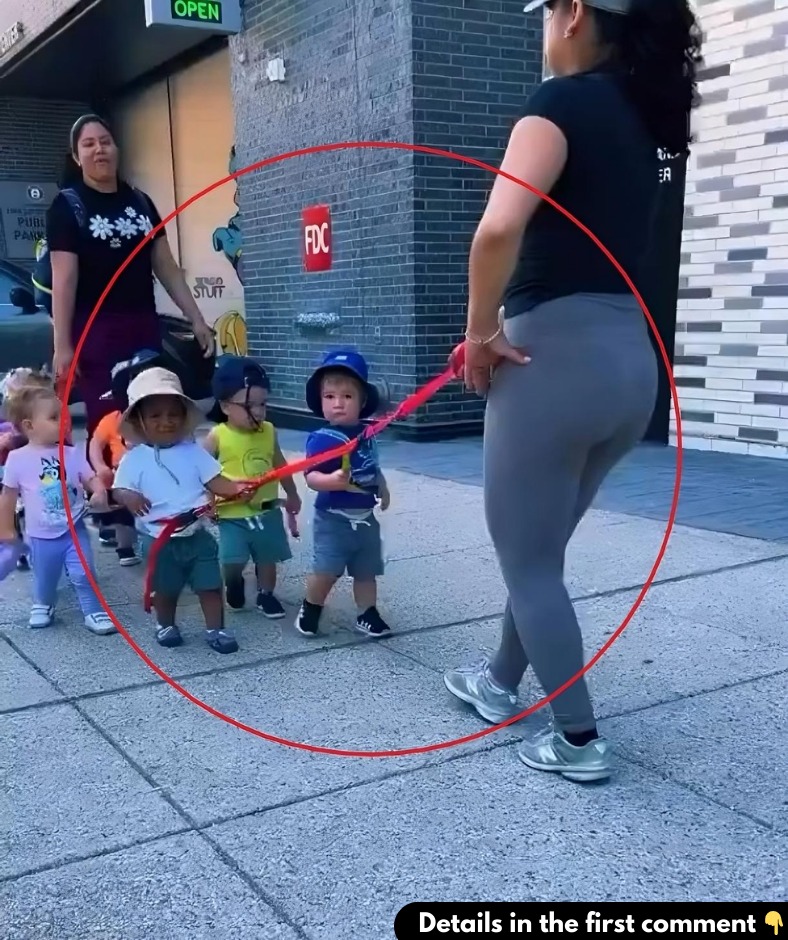A recent video has sparked a heated debate after showing a teacher leading a group of children on a walk, but with an unexpected twist: the children are tied together to prevent them from getting lost. The video’s caption reads, “Their teacher took them for a walk and tied them up so they wouldn’t get lost.” This scenario raises significant ethical questions about whether this approach is suitable for student safety or whether it goes too far.

Understanding the Teacher’s Intention
At first glance, it’s clear that the teacher’s primary concern was student safety. When taking young children outdoors, especially in crowded or unfamiliar areas, keeping the group together is crucial. The teacher likely viewed tying the children together as a practical solution to ensure no one wandered off and that the group stayed intact.
While the goal of maintaining safety is understandable, the method used—physically tying children together—raises immediate concerns. Ensuring safety is essential, but any approach must also respect the children’s dignity, comfort, and autonomy. This balance is what makes the situation so controversial.
The Question of Safety Versus Comfort
Safety is a top priority in any educational setting, and teachers have the responsibility to protect children from harm. This duty becomes even more critical when students are off school grounds, where the risk of losing a child in a crowd or open area increases. Given this, the teacher’s approach to preventing such an incident makes sense.
However, tying children together involves a level of physical restraint that can be perceived as demeaning. Children deserve to feel safe, but they also need to feel respected and trusted. Using ropes or ties to keep them together can make it seem as though they are being controlled rather than cared for.
There are alternative methods that can ensure safety without resorting to physical restraint. Child-friendly walking ropes, for example, allow children to hold onto a rope while walking in a line, which maintains cohesion without making them feel tied down. Organizing students into smaller groups with designated leaders or encouraging them to hold hands are other methods that promote safety while respecting the children’s autonomy.
Potential Psychological Effects
Beyond the physical restraint, there are psychological implications to consider. Even with the best intentions, tying children together could make them feel embarrassed, scared, or humiliated. For young children still developing a sense of independence, this experience could diminish their trust in the teacher.
Children may not understand why they are being tied up, leading to feelings of helplessness or powerlessness, which can cause anxiety. Even in situations where safety is the top priority, educators must foster a sense of security without compromising emotional well-being. Actions that cause discomfort can leave lasting negative impressions, potentially affecting a child’s relationship with authority figures.
Legal and Ethical Considerations
Legally, physical restraint of children in educational settings is a sensitive issue. Many regions have strict rules on how teachers can physically interact with students, especially regarding restraint. Tying children together could cross a line, potentially leading to legal action or school policy violations.
Ethically, teachers are held to a high standard of care. They are responsible for ensuring students’ physical and emotional well-being. Restraining children, even with good intentions, can be viewed as abusive or inappropriate, raising concerns among parents, guardians, and educators. This makes it a topic worthy of careful consideration.
Is It a Matter of Overreach?
The key question here is whether tying the students together was necessary or an overreach. While the teacher’s intent was likely to ensure safety, the approach seems to have crossed an ethical boundary. Physically tying up children, even temporarily, conveys a sense of restraint that conflicts with the values of trust and respect that educators should promote.
There are safer ways to prevent children from getting lost that maintain their dignity. Child-friendly ropes, group leaders, or holding hands in pairs promote safety without introducing ethical or psychological issues. Teachers need to choose methods that prioritize both safety and respect for the children in their care.
Reevaluating Safety Practices in Education
This incident sheds light on broader issues regarding safety measures in schools. Teachers often struggle to balance the need for protection with fostering independence, trust, and mutual respect. It’s essential to approach safety holistically, considering not only physical risks but also emotional impacts.
The method used in the video should prompt schools and policymakers to reflect on what constitutes appropriate safety measures for children. It’s possible to create a safe environment without compromising children’s comfort or sense of agency.
Conclusion: Balancing Safety and Respect
The video of the teacher tying students together has sparked an important debate about the extent to which educators should go to ensure safety. While the teacher’s intention was clear, the chosen method raises ethical concerns about treating children with respect.
Striking a balance between ensuring safety and respecting children’s rights is crucial. Teachers must be creative and mindful in choosing methods that protect students without causing unnecessary discomfort. By adopting solutions that are both effective and humane, educators can foster environments where safety and respect coexist.
The ultimate goal should be to create a safe, trusting, and respectful learning environment, using methods that protect children’s well-being while preserving their autonomy and comfort.





